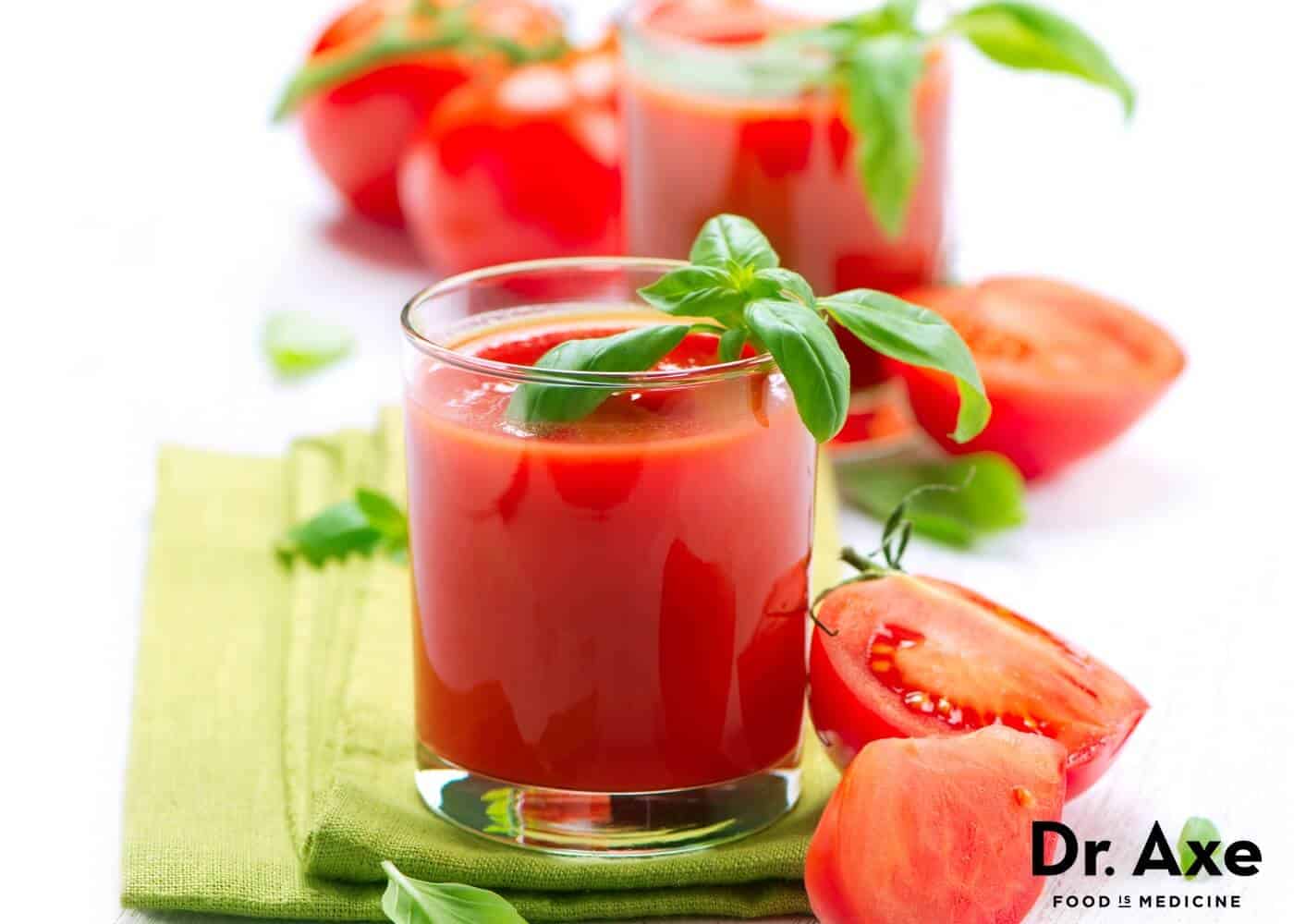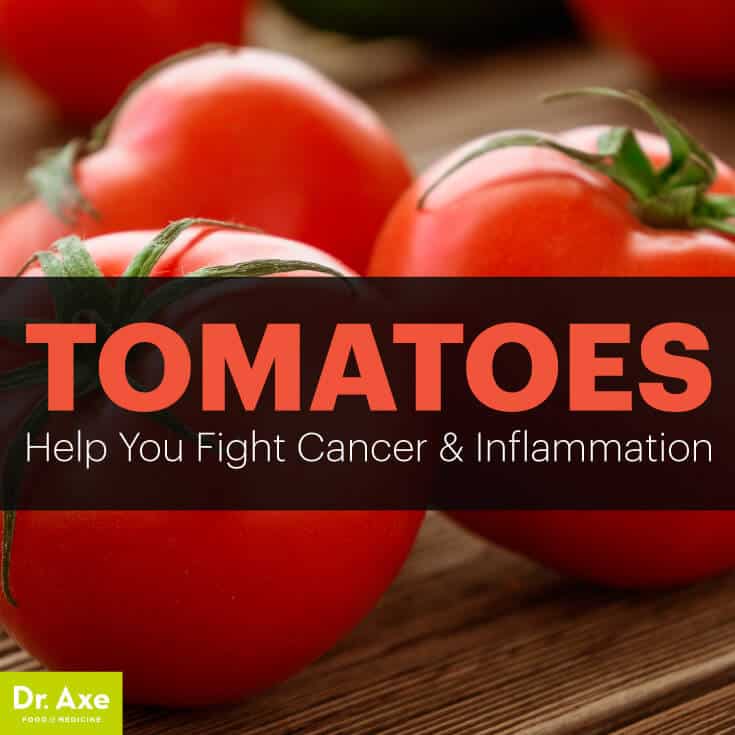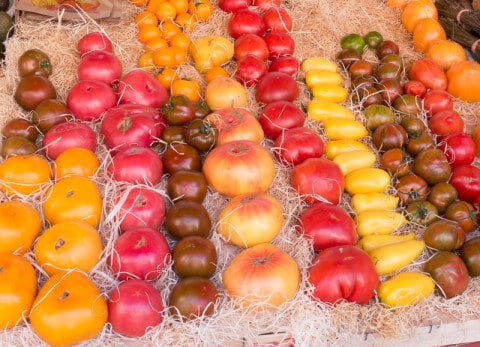Tomato Nutrition Helps You Fight Cancer & Inflammation
Did you know that it’s believed over 7,500 different tomato species are grown around the world today? You’ve probably heard before that, botanically speaking, tomatoes are actually a fruit and not a vegetable. In fact, technically they’re considered a berry, although strangely a long-standing United States law dating back to the late 1800s classifies them as a vegetable.
Tomatoes have a long history dating back thousands of years to around the time of 500 B.C. in Mexico, where they were a staple crop for the Aztecs and eaten along with beans and corn. Aztecs and other peoples in the Mesoamerica area used the slightly sweet “fruit” in many diverse ways and even held tomatoes in high spiritual regard — tomato seeds were believed to be “blessed with powers of divination.”
Tomatoes are one of those easy-to-use anti-inflammatory foods that luckily taste great, too. According to the Department of Food Sciences at North Carolina State University in regard to a study on tomato nutrition, “Tomatoes are the second most produced and consumed vegetable nationwide and are a rich source of lycopene, beta-carotene, folate, potassium, vitamin C, flavonoids, and vitamin E.”
Tomato Nutrition Facts
Tomatoes (which have the scientific name Solanum lycopersicum) are a member of thenightshade vegetable family called Solanaceae, which also includes veggies like peppers, eggplant and potatoes. They are considered a high-antioxidant food and one of the best sources of the phytonutrient called lycopene in the world, which is closely tied to enhanced immunity and cancer risk reduction. Although most people correlate lycopene with deeply colored red tomatoes, it’s believed to present in equally high quantities in organic yellow, green or orange tomatoes.
Lycopene found in tomatoes has well-researched beneficial effects when it comes to stalling cancerous tumor growth. Adults with cancer who have participated in studies commonly show signs of cancer regression and tumor malignancy with supplementing with high doses of lycopene. Research has shown that when lycopene supplements are given to men who already have existing prostate cancer, the lycopene helps to reduce the size of the tumors and stop the spreading of cancerous cells.
While lycopene is most researched in regards to tomato nutrition benefits and prostate cancer prevention, it’s beneficial for defending against other types, too. Strong evidence indicates that higher lycopene intake can help protect against lung, stomach, colon, oral, breast and cervical cancers. Additionally, tomatoes supply many other forms of antioxidants and a wide range of vitamins, in addition to potassium and phosphorus.
1 medium tomato has about:
- 22 calories
- 1 gram protein
- 3 grams sugar
- 5 grams carbs
- 1 gram fiber
- 6 milligrams vitamin C (26 percent DV)
- 1025 milligrams vitamin A (20 percent DV)
- 7 milligrams vitamin K (12 percent DV)
- 292 milligrams potassium (8 percent DV)
- 1 milligram manganese (7 percent DV)
- 1 milligram vitamin B6 (5 percent DV)
- 4 milligrams folate (5 percent DV)
6 Tomato Nutrition Benefits
1. Loaded with Cancer-Fighting Antioxidants
Studies over the past several decades have found that people who eat more tomatoes are less likely to suffer from prostate cancer, which is the most common form of cancer in American men. Cooked tomatoes are especially beneficial for fighting cancer because once cooked (especially with a source of fat, like olive oil) their rich source of the carotenoid antioxidants called lycopene becomes even more available.
As a natural cancer remedy, researchers have known about the immune-enhancing effects of foods containing lycopene for decades. Studies dating back to the 1990’s conducted by Harvard University Medical School found that men who ate the most tomatoes had a much lower risk of developing prostate cancer than non-tomato eaters. Some of the men were eating as much as 10 servings a week (or more) of tomatoes – including from sources like tomato juice, tomato sauce and raw tomatoes. At least five studies support a 30 percent to 40 percent reduction in prostate cancer risk associated with high tomato or lycopene consumption.
Recently a large report published by the Royal Victoria Hospital and McGill University of Montreal investigated 11 case-control studies and 10 cohort studies on the use of tomato, tomato products or lycopene for cancer prevention; they found that tomatoes, especially when eaten in high amounts, offer significant protection.
And besides lycopene, tomato nutrition contains a variety of other powerful phytochemicals that can help fight widespread chronic diseases. For example, research shows that phenolic acids found in tomatoes have the potential to fight lung cancer because of their ability to inhibit the formation of nitrosamine compounds in the body.
2. Acts as a Natural Anti-Inflammatory
Tomatoes’ deep color is a good indication of their high supply of inflammation-fighting antioxidants – which is exactly why many nutrition experts tell you to “eat the rainbow.” Tomatoes are especially known for having a trio of antioxidants called zera-carotene, phytoene and phytofluene that are found together in many brightly colored fruits and vegetables. These are effective for helping to lower disease-causing inflammation and thus slow age-related diseases like heart disease, cancer, diabetes, arthritis and cognitive decline.
One of the possible mechanisms for tomatoes’ protective activities is by “down-regulation of the inflammatory response.” That includes inhibiting pro-inflammatory mediators (such as the reduction of reactive oxygen species), halting pro-inflammatory cytokines from being released and changing nitric oxide signal pathways.
However, keep in mind that processing of tomatoes may significantly affect the bioavailability of these anti-inflammatory nutrients. Homogenization, high heat treatment/cooking, and the incorporation of oil in processed tomato products leads to increased lycopene bioavailability — unfortunately, at the same time, these processes can cause significant losses of other delicate nutrients. This is why it’s a good idea to eat both raw and cooked tomatoes regularly.
3. Helps Improve Heart Health
Tomatoes’ antioxidants, especially lycopene, are known to fight free radical damage and thus protect the heart against oxidative stress. This offers protection related to heart disease – which is the number one cause of death in the U.S and many other nations – and lowers the risk for heart attacks or strokes. Some studies have found that treatment with antioxidant-rich tomato extract can alsoreduce high blood pressure, lower cholesterol naturallyand improve blood vessel health.
In a recent study, healthy adults ingesting lycopene in the form of tomato juice, tomato sauce, and soft gel capsules for one week had significantly lower levels of LDL oxidized cholesterol compared with control groups. Possible mechanisms for tomatoes improving heart health include enhanced LDL degradation, LDL particle size and composition, less plaque build-up, and altered blood vessel function.
Researchers understand that the many nutrients found in tomatoes partially function individually, but also work together in many ways to protect lipoproteins and vascular cells from oxidation. For example, lutein found in tomatoes can also help prevent or slow down the thickening of the arteries.
Oxidation is the most widely accepted theory for the development of atherosclerosis, or hardening and thickening of the arteries that can lead to cardiovascular disease. Tomatoes are also a good source of potassium, and can help prevent blood pressure problems due to low potassium intake.
4. Helps Protect Vision and Eye Health
A protective compound called lutein is present in tomatoes, and it’s very healthy for your eyes. Lutein is often studied in regards to eye health because it protects the eye’s retina that we need for healthy vision. The retina is especially vulnerable during old age due to long-term damage of UV light radiation and oxidative stress from other factors. Among the many carotenoids present in the body, only lutein and zeaxanthin are found in that portion of the eye where light is focused by the lens, called the macula lutea.
Research shows that lutein in tomatoes might act like a natural macular degeneration treatment. Keep in mind that macular degeneration is the leading cause of blindness in older adults. For people not at a high risk for macular degeneration, eating tomatoes is just a good way to help improve vision and prevent cataracts or general deterioration of delicate eye tissue.
5. Benefits Skin Health
When it comes to fighting skin cancer with food, tomatoes should be at the top of your list. Tomatoes are an excellent vitamin C food, and vitamin C is crucial for keeping skin’s immunity, elasticity, appearance and complexion strong into older age. One thing to note is that the vitamin C in tomatoes is most concentrated in the gel-like substance that surrounds tomato seeds – so be careful not to let this valuable juice “bleed out” too much and go to waste when cutting tomatoes.
Tomatoes’ lutein also benefits skin health. Lutein is naturally present in the skin and animal studies have provided evidence of lutein’s significant protection against light-induced skin damage or skin cancer, especially from ultraviolet wavelengths.
6. Helps Protect Bone Health
Recently lycopene has been linked to better bone health, especially in elderly people. A study investigating the effects of dietary sources of lycopene in the diets of older women found that those who lacked significant lycopene intake were at a higher risk for bone-related diseases and possibly osteoporosis.
This is why tomatoes and other lycopene-containing foods are recommended as part of an anti-aging, healing diet. Tomatoes are also a good source of nutrients like manganese, phosphorus and bone-building vitamin K.
History of Tomatoes and Interesting Facts
The original tomato species first grew in parts of South America, particularly in the Andes Mountains, thousands of years ago. At the time, wild tomatoes appeared lumpier and were not as sweet or smooth as the modern day kind. They spread throughout the world following the Spanish colonization of the Americas when sailors brought them back to Europe on their ships.
Spanish conquistador Hernán Cortés is believed to be the first to transfer the small yellow tomato to Europe after he captured the Aztec city of Tenochtitlan, now Mexico City, in 1521. Europeans first believed that tomatoes were a type of eggplant (they weren’t far off) and divided them into segments to be cooked and seasoned with salt, black pepper and oil. After the Spanish colonization of the Americas, the Spanish distributed tomatoes throughout their colonies in the Caribbean and brought them to parts in Asia, including the Philippines.
The tomato grows easily in warm climates, so it spread across the Mediterranean and began widely being grown around the 1540s. The earliest discovered cookbook with tomato recipes was published in Naples, Italy in 1692! In Italy, tomatoes were grown mainly for decorations at first and weren’t considered a staple food for the common peasant population because they were not as filling as other fruits. It took several hundred years for different types of tomato species to appear and for recipes like marinara pasta sauce, pizza and chicken Parmesan to become popular.
How to Buy and Use Tomatoes
Today, tomatoes are one of the most common vegetables (or fruits) grown in the U.S. in people’s own gardens. They even have a reputation for “out-producing the needs of the growers” because they tend to take off and grow loads of tomatoes all at once during the summer months. “Heirloom” tomatoes have especially become popular among home gardeners and organic producers since they come in a variety of bright colors, varying tastes and sizes. China, India, the U.S and Turkey are the leading growers of tomatoes worldwide.
Look for vine-ripened tomatoes at farmers market or specialty stores and ideally choose organic tomatoes when possible. Amazingly some research suggests that a tomato grown in a greenhouse (or hot-house) has about half the vitamin C content as its vine-ripened cousin!
So whenever possible try to use fresh brightly colored vine-ripened tomatoes, which will hold a higher level of antioxidants and nutrients. Tomatoes that are ready to eat should be soft but still somewhat firm. Usually the softer the get, the riper they are and sweeter they taste. Keep them stored out of the refrigerator and try eating them within several days of ripening (or make some sauce!)
On a side note, tomatoes are thought to be one of the foods that people rarely get to appreciate at their peak because many commercially grown tomatoes are picked when under-ripe and green and then made to artificially ripen using greenhouses that hold ethylene gas. This might mean your tomato looks normal and red when it’s available for you to purchase in grocery stores, but neither will the nutrients be the same nor will the taste be comparable to the real thing.
Remember that the protective properties of lycopene, especially when it comes to cancer prevention, are most beneficial and absorbable when they’re consumed with a fat-rich food. This is why it’s a great idea to eat tomatoes along with healthy fats likeavocado, olive or coconut oil, nuts and seeds, or fatty fish like salmon. Why is this the case? Carotenoids are fat-soluble nutrients, which means they get maximum absorption only when you eat them with a source of natural fat.
This doesn’t mean you should make a point to eat greasy pizza all the time, however! It just means to make a point of adding some real, oil-based dressing to your salad, or other forms to fat to veggie-based meals (including those with leafy greens or cruciferous veggies, which also have fat-soluble nutrients) in order to boost your absorption.
Healthy Tomato Recipes
You can use all types of tomatoes – whether roma, beef steak, cherry or grape – in diverse ways, including eating them raw, adding them to sauces cooked or even having some in a juice or smoothie. Tomatoes go great with garlic, oil, fresh herbs of all kinds (especially basil and parsley), onions, avocado, peppers, beans and leafy greens.
Total Time: 5 minutes
Serves: 2
INGREDIENTS:
- 2 tomatoes
- 1/2 Cucumber
- 1 cup fresh basil
- pinch of sea salt
DIRECTIONS: Add all ingredients to vegetable juicer. Gently stir juice and consume immediately.

Potential Interactions of Eating Tomatoes
Although tomatoes come loaded with benefits, keep in mind that they are a nightshade vegetable that can aggravate health conditions for some people. Green tomatoes contain a substance called solarnine, which may be aggravating to people with conditions like arthritis or some other autoimmune-related diseases. Nightshade vegetables are also somewhat of a common allergy, at least when it comes to fruits and vegetables.
Many health professionals council people with painful arthritis symptoms to avoid nightshades altogether, although some say the benefits of doing this will vary a lot depending on someone’s exact tolerance – so it isn’t always necessary to do so. Tomatoes are also usually avoided by people with gerd, or other reflux disorders like heartburn because of their higher level of acid.
If you have acid reflux symptoms or stomach, joint or muscle pain frequently, laying off tomatoes might be smart to test your reaction. Or if you experience unexplained digestive issues that might suggest a possible food sensitivity, you can try doing anelimination diet that cuts out all nightshade vegetables, including all types of tomatoes. These diets are usually most helpful when you follow them strictly for at least six weeks, so although this might sound a little daunting, it’s worth a try for helping to reduce further inflammation and swelling.







Comments
Post a Comment